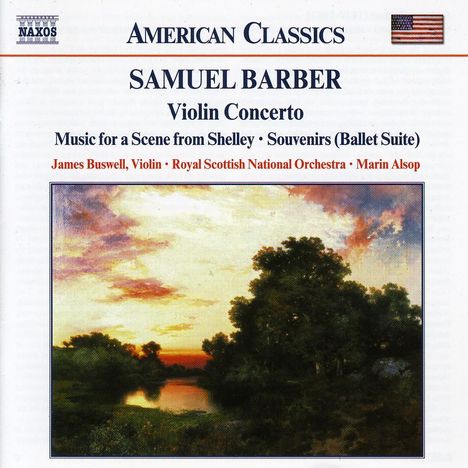Samuel Barber: Violinkonzert op.14 auf CD
Violinkonzert op.14
Herkömmliche CD, die mit allen CD-Playern und Computerlaufwerken, aber auch mit den meisten SACD- oder Multiplayern abspielbar ist.
Lassen Sie sich über unseren eCourier benachrichtigen, falls das Produkt bestellt werden kann.
+Souvenirs op. 28; Streicherserenade op. 1; Music for a Scene from Shelley
- Künstler:
- James Buswell, Royal Scottish National Orchestra, Marin Alsop
- Label:
- Naxos
- Aufnahmejahr ca.:
- 99-01
- UPC/EAN:
- 0636943904428
- Erscheinungstermin:
- 26.11.2001
- Serie:
- Naxos American Classics
Ähnliche Artikel
Das Violinkonzert, Opus 14, wurde von Samuel Fels für Iso Briselli in Auftrag gegeben. Das dreisätzige Konzert, zweifelsohne eines der beliebtesten Werke Barbers, wurde im Juli 1940 fertiggestellt und am 7. Februar 1941 vom Philadelphia Orchestra unter der Leitung von Eugene Ormandy uraufgeführt, Solist war tatsächlich der bekannte Geiger Albert Spalding. Die fast kammermusikalische Intimität des Konzerts spiegelt sich in der Besetzung für acht Holzbläser, zwei Hörner, zwei Trompeten, Schlagzeug, Klavier und Streicher wider. Unter Verzicht auf die übliche Orchestereinleitung beginnt der erste Satz mit der Solovioline, die das Hauptthema vorgibt, während der zentrale langsame Satz ebenfalls mit einem einleitenden Solo beginnt, diesmal gespielt von der Oboe. Der dritte Satz "Presto in moto perpetuoso" sorgt für ein besonders markantes Finale.
Die Ballettsuite Souvenirs, Opus 28, besteht aus einem Walzer, Schottischen, Pas de deux, Two-step, Tango und Galopp. Ursprünglich als vierhändige Klaviersuite komponiert, beendete Barber die Orchestrierung des Balletts im Sommer 1952. Im Vorwort zur Fassung für Klavier zu vier Händen schrieb Barber: "Man könnte sich ein Divertissement in einer Kulisse des Palmenhofes des Hotel Plaza in New York vorstellen, im Jahr um 1914, der Epoche der ersten Tangos; 'Souvenirs' - in liebevoller Erinnerung, nicht in Ironie oder mit frecher Zunge, sondern in amüsierter Zärtlichkeit".
Die entzückende Serenade für Streicher, Opus 1, ist Barbers eigene Bearbeitung seiner Serenade für Streichquartett, die er 1928 komponierte, als er gerade achtzehn Jahre alt war und noch bei Scalero studierte. In drei kurzen Sätzen, Un poco adagio - Allegro con spirito, Andante und Allegro giocoso, weist das Werk zwei sehr charakteristische Stilmerkmale auf, nämlich die Überlagerung von Zweier- und Dreiertakten und die überraschenden Verschiebungen zwischen Dur- und Molltonarten.
Product Information
The Violin Concerto, Opus 14, was commissioned by Samuel Fels for Iso Briselli. Unquestionably one of Barber’s most popular works, the three-movement concerto was completed in July 1940 and given its première on 7th February 1941 by the Philadelphia Orchestra conducted by Eugene Ormandy, when the soloist was actually the well known violinist Albert Spalding. The almost chamber-like intimacy of the concerto is reflected in the scoring for eight woodwind, two horns, two trumpets, percussion, piano and strings. Dispensing with the customary orchestral introduction the first movement opens with the solo violin stating the principal subject, while the central slow movement similarly begins with an introductory solo, this time played by the oboe. The perpetuum mobile third movement provides a particularly striking finale.
The ballet suite Souvenirs, Opus 28, consists of a waltz, schottische, pas de deux, two-step, tango and galop. Originally composed as a four-hand piano suite, Barber finished orchestrating the ballet in the summer of 1952. In the preface to the version for piano, four hands, Barber wrote: "One might imagine a divertissement in a setting of the Palm Court of the Hotel Plaza in New York, the year about 1914, epoch of the first tangos; ‘Souvenirs’ – remembered with affection, not in irony or with tongue in cheek, but in amused tenderness".
The delightful Serenade for Strings, Opus 1, is Barber’s own arrangement of his Serenade for String Quartet, composed in 1928 when he was just eighteen and still studying with Scalero. Cast in three short movements, Un poco adagio - Allegro con spirito, Andante and Allegro giocoso, the work exhibits two highly characteristic stylistic traits, namely the superimposition of duple and triple metres and the surprising shifts between major and minor tonalities.
Disk 1 von 1 (CD)
-
1 Violin Concerto, Op. 14: I. Allegro
-
2 Violin Concerto, Op. 14: II. Andante
-
3 Violin Concerto, Op. 14: Iii. Presto In Moto Perpetuoso
-
4 Souvenirs, Op. 28 (version for orchestra): I. Waltz (The Lobby)
-
5 Souvenirs, Op. 28 (version for orchestra): II. Schottische (Third Floor Hallway)
-
6 Souvenirs, Op. 28 (Version For Orchestra): Iii. Pas De Deux (A Corner Of The Ballroom)
-
7 Souvenirs, Op. 28 (version for orchestra): IV. Two-Step (Tea in the Palm Court)
-
8 Souvenirs, Op. 28 (version for orchestra): V. Hesitation-Tango (A Bedroom Affair)
-
9 Souvenirs, Op. 28 (version for orchestra): VI. Galop (The Next Afternoon)
-
10 Serenade, Op. 1: I. Un poco adagio - Allegro con sprito
-
11 Serenade, Op. 1: II. Andante con moto
-
12 Serenade, Op. 1: Iii. Dance - Allegro Giocoso
-
13 Music for a Scene from Shelley, Op. 7









